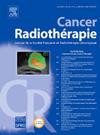放疗与食管癌患者继发原发性恶性肿瘤风险之间的关系:一项基于人群的研究,利用17个监测、流行病学和最终结果癌症登记处
IF 1.4
4区 医学
Q4 ONCOLOGY
引用次数: 0
摘要
目的:尽管放疗作为食管癌的标准治疗方法已被广泛使用,但由于放疗相关副作用而导致第二原发性恶性肿瘤的潜在风险仍未得到充分研究。方法:我们使用来自监测、流行病学和最终结果(SEER)数据库中的17个癌症登记处的大队列数据进行了全面分析。为了估计与放疗相关的第二原发恶性肿瘤的发生率,我们采用了泊松回归和竞争风险回归模型。结果从SEER数据库中共发现54,844例食管癌患者。其中,8351例患者未接受放疗,15555例患者接受了放疗。接受放疗的患者第二原发恶性肿瘤的发生率为6.28%(977例),而未接受放疗的患者发病率为7.09%(592例)(P <;0.0001)。在校正了年龄、性别、诊断年份、肿瘤分级和化疗等潜在混杂因素后,接受放疗的患者的发病率明显高于未接受放疗的患者(比值比[OR]泊松回归= 1.18,95%可信区间[CI]: 1.05-1.32, P = 0.018;OR多变量竞争风险回归= 1.15,95% CI: 1.04 ~ 1.26, P = 0.018)。值得注意的是,接受放射治疗的患者患肺癌、乳腺癌和胃癌的风险增加。此外,年轻的食管癌患者似乎更容易受到影响,在食管癌诊断后10年以上发生原发性恶性肿瘤的风险最高。结论食管癌放疗与整体癌症发生风险增加有关。至关重要的是解决和减轻与放疗相关的第二原发性恶性肿瘤的风险,同时改善受这些继发性恶性肿瘤影响的患者的预后。本文章由计算机程序翻译,如有差异,请以英文原文为准。
Association between radiotherapy and risk of secondary primary malignancies in patients with esophageal cancer: A population-based study utilizing 17 Surveillance, Epidemiology, and End Results cancer registries
Purpose
Despite the frequent use of radiotherapy as a standard treatment for esophageal cancer, the potential risk of developing second primary malignancies as a result of radiation-related side effects remains underinvestigated.
Methods
We conducted a comprehensive analysis using data from the large cohort of 17 cancer registries within the Surveillance, Epidemiology, and End Results (SEER) database. To estimate the incidence of second primary malignancies associated with radiotherapy, we employed Poisson regression and competing risk regression models.
Results
A total of 54,844 patients diagnosed with esophageal cancer were identified from the SEER database. Among them, 8351 patients did not receive radiotherapy, while 15,555 patients were treated with radiation. The incidence of second primary malignancies among patients who had radiotherapy was 6.28 % (977 patients) compared to an incidence of 7.09 % (592 patients) for those who had not (P < 0.0001). After adjusting for potential confounders, such as age, gender, year of diagnosis, tumor grade, and chemotherapy, the incidence rates of patients who received radiotherapy were significantly higher compared to those who had not (odds ratio [OR] Poisson regression = 1.18, 95 % confidence interval [CI]: 1.05–1.32, P = 0.018; OR multivariable competing risk regression = 1.15, 95 %CI: 1.04–1.26, P = 0.018). Notably, patients who received radiotherapy were found to be at an increased risk of developing lung cancer, breast cancer, and gastric cancer. Additionally, younger patients with esophageal cancer appeared to be more susceptible, with the highest risk of developing subsequent primary malignancies observed more than 10 years after the esophageal cancer diagnosis.
Conclusion
Our findings indicated that radiotherapy for esophageal cancer was associated with an increased risk of developing overall cancer. It is crucial to address and mitigate the risk of second primary malignancies associated with radiotherapy, while also improving the prognosis for patients affected by these secondary malignancies.
求助全文
通过发布文献求助,成功后即可免费获取论文全文。
去求助
来源期刊

Cancer Radiotherapie
医学-核医学
CiteScore
2.20
自引率
23.10%
发文量
129
审稿时长
63 days
期刊介绍:
Cancer/radiothérapie se veut d''abord et avant tout un organe francophone de publication des travaux de recherche en radiothérapie. La revue a pour objectif de diffuser les informations majeures sur les travaux de recherche en cancérologie et tout ce qui touche de près ou de loin au traitement du cancer par les radiations : technologie, radiophysique, radiobiologie et radiothérapie clinique.
 求助内容:
求助内容: 应助结果提醒方式:
应助结果提醒方式:


